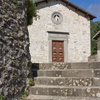Castle of Lupinaia
Lupinaia is an ancient village which was fortified in mediaeval times. Of the ancient walls built to protect the village, one of the two doors is still in good condition.
Inside the Church of the Madonna Addolorata there is one of the finest paintings of the seventeenth century from Lucca, San Rocco by Pietro Paolini.
Historical notes
The first reliable information about the presence of the small community comes from 1167, the year in which it was quoted in the oratory of the Vergine della Stella, a chapel which does not appear in subsequent documents and which has survived in its seventeenth-century form. The memoires of the Sercambi are interesting, telling how this place, probably fortified by the Porcaresi family, was destroyed and burned by the Lucca militia who entered the valley in 1170 to quell the riots of the "nobiles". The village's defences were probably destroyed and were not rebuilt until the late fourteenth century, when the Sercambi inserted the "fortress" of Lupinaia in the number of fortifications that were always to be kept guarded.
The village, in fact, had become come under the City of Lucca and remained faithful even when events were turning for the worst. In the fourteenth century, it broke away from the Vicariate of Barga, becoming part of that of Gallicano, while after 1430, when many communities were entrusted to the Este family in search of protection, Lupinaia – along with Riana and Treppignana – decided to remain with Lucca.









